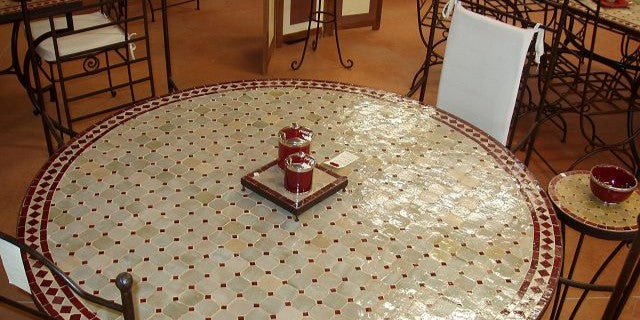
Moroccan zellige mosaic tablesa from Fez show centuries of artistic tradition. Each handmade piece tells story of heritage and skill passed down through generations in ancient city of Fez.
Frequently Asked Questions About Zellige Mosaic Tables
What is zellige tilework?
Zellige comes from Arabic word "al zulaycha" which means "little polished stone." This special technique uses small glazed terracotta pieces in different colors to create beautiful geometric patterns. Zellige is very important part of Maghrebi architecture and shows deep cultural tradition.
How artisans in Fez make authentic zellige mosaic tables?
Our Maâlems (master artisans) start with special clay from Fez region. They carefully knead clay by hand, shape it, dry it in sun, then fire in traditional kiln. After this, they apply rich glazes in colors that show Morocco's landscapes - blues, greens, reds, and whites. Using only simple chisel and hammer called Menqach, artisan cuts each tile into exact shape needed for pattern. All this knowledge passes from father to son for many generations.
Why Fez artisans known for best zellige craftsmanship?
Fez has been center of zellige making for centuries. Clay from areas around Fez has perfect qualities for zellige. Our artisan families keep workshops in old medina where techniques stay true to tradition. Fez craftsmen learn from young age, spending years to master each step of process. This is why zellige from Fez has quality that cannot be copied by machine or by artisans from other places.
What makes each zellige table unique?
Each table shows small variations that come from hand of maker. These tiny differences in color, shape, or pattern are sign of true handmade piece. Many customers appreciate these subtle marks as proof of authenticity. If zellige looks too perfect with exact same tiles, it is probably made by machine, not by true Fez artisan.
Traditional Craftsmanship and Materials
Creating genuine mosaic tables using zellige technique requires specific materials and skilled hands that influence both beauty and strength. This craft shows generations of artisans keeping tradition through careful work that needs patience and attention to small details.
Our Maâlems begin with raw clay from special areas around Fez where clay has natural purity perfect for zellige. Clay is kneaded by hand until it has right feel and consistency. Shaped tiles dry in sun before going into traditional wood-fired kiln where temperature transforms clay into strong ceramic ready for glaze.
Glazes use colors that show beauty of Morocco - deep blues like sky over Chefchaouen, greens that represent Islam, warm terracottas like desert sand, and pure whites that remind of Atlas mountains snow. Each color mixes by hand to keep rich depth that machine-made products cannot match.
True heart of zellige art is in hands of Maâlem. Using only simple chisel and knowledge passed through family, artisan makes precise cuts to shape tiles for pattern. This geometric work happens without computer drawings or modern tools - only eye and hand working together from memory and experience. Cuts happen in three steps: drawing pattern on glazed tile, cutting shape with sharp hammer, and making edges smooth with smaller hammer.
After cutting, small pieces arrange face-down on floor following drawing made by master. This method, used for hundreds of years, creates tight, exact patterns that modern factories cannot copy. Often many artisans work together on one table. When pattern is complete, mortar fixes pieces in place, sometimes with iron rods for extra strength. Then finished top attaches to table base.
Unique Qualities and Appeal
Unlike factory furniture, each mosaic table carries unique touches that show skilled hands that made it. Many customers tell us they love subtle differences in color and shape that happen naturally in handmade pieces, seeing them as signs of real quality rather than problems.
These handcrafted tables stay beautiful through changing home styles, making them good addition to many types of rooms. Geometric patterns work well with many décor styles, from modern to traditional. Interior designers often suggest mosaic tables as investment pieces that keep visual impact through years of changing fashions.
Beyond beauty, mosaic tables offer practical benefits. Durable surface resists heat damage from hot cups or plates. Glazed tiles clean easily with simple wipe and resist stains. Unlike wood, quality mosaic top develops character over time without getting worse. This strength makes them become family treasures passed to next generation.
Zellige tiles also resist wear, water, light foot traffic, and stay slip-resistant, heat-resistant, and stain-resistant for many years. They work in many places around home, including on tables, walls, and even in bathrooms. Making zellige mosaic can take between 3 weeks and 3 months depending on size and pattern complexity, showing deep commitment to craft that is becoming rare in today's world of quick, cheap products.
